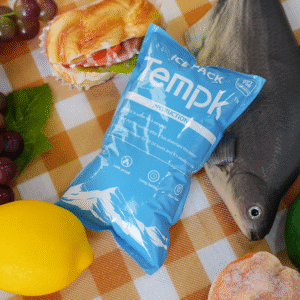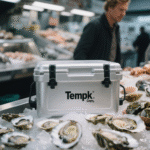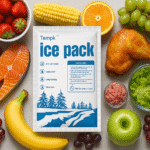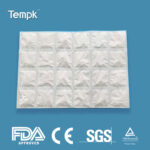Dry ice packs for travel keep food, Meeresfrüchte, and medicine truly frozen on long trips. In most itineraries you can bring up to 2.5 kg per passenger if the package is vented and clearly labeled, and a smart pack-out can extend runtime by a day or more versus gel packs. Below you’ll find airline rules, a sizing estimator, and step‑by‑step packing that you can use today.

This article will help you:
-
Wählen dry ice packs for travel vs. PCM vs. gel for your route and duration
-
Size how much dry ice you need using a day-by-day estimator
-
Pack and label correctly to meet airline dry ice rules
-
Prevent thawing with pre-chill, layering, and void fill techniques
-
Travel safely by car, train, or cruise with proper ventilation
-
Track 2025 trends in reusable PCM systems and policy continuity
Sind dry ice packs for travel allowed on planes in 2025?
Ja. You can typically carry up to 2.5 kg (5.5 lb) per passenger in carry-on or checked baggage if the container is vented, labeled “Dry ice / Carbon dioxide, solide,” and the airline is notified. Label the net weight or state “≤ 2.5 kg.” At security, gel packs are allowed only if fully frozen at screening. Plan ahead and confirm carrier specifics.
What this means for you: use a vented hard cooler (Niemals luftdicht), add a visible label and weight, and note the dry ice with your airline before departure. Keep any gel packs rock-solid at screening to avoid the liquids rule. These practices line up with airline and airport guidance in 2025 and keep you compliant without surprises.
How much dry ice packs for travel do you need?
Rule of thumb: plan on 5–10 lb per 24 Std. in a quality cooler. Start with 8 lb/day for a mid‑size hard cooler, add +2 lb/day for hot weather or frequent openings, and keep a 25% buffer for delays. A five‑pound block often covers a roughly 18–24 hour flight day in a good cooler.
| Trip Duration | Baseline (hard cooler) | Hot/Opened Often | Suggested Total (incl. 25% buffer) | What it means for you |
|---|---|---|---|---|
| 12 Std. | 4 lb | 6 lb | 5–8 lb | Overnight hop or long layover |
| 24 Std. | 8 lb | 12 lb | 10–15 lb | Typical door‑to‑door flight day |
| 36 Std. | 12 lb | 18 lb | 15–22 lb | Long itinerary with connections |
| 48 Std. | 16 lb | 24 lb | 20–30 lb | Add pre‑chill and minimize openings |
Practical tips you can use today
-
Use a vented container: latch the lid but don’t tape seams airtight.
-
Place dry ice on top: cold air sinks; keep food/medicine below with a spacer.
-
Fill air gaps: towels or paper reduce heat gain and extend hold time.
-
Carry a thermometer: verify ≤40°F for chilled goods or <0°F for frozen.
Real‑world case: A traveler on a 28‑hour route used a 45‑quart rotomolded cooler, ~12 lb dry ice on top, and minimal openings. The contents arrived rock‑solid with 8–10 hours of margin thanks to pre‑chill and tight packing.
How should you pack dry ice packs for travel to maximize runtime?
Keep items frozen solid, pre‑chill the cooler 12–24 hours, layer a spacer above the goods, stack dry ice on top, and fill voids. Add a simple label before check‑in and avoid any airtight seals so CO₂ can vent safely. This set‑up materially extends runtime and reduces waste.
Why it works: insulation absorbs heat; pre‑chilling reduces the load your dry ice must absorb. A spacer (rack/cardboard) prevents freeze damage, while void fill limits warm air exchange. Checking temperature on arrival is the easiest confidence check after a long layover.
Step‑by‑step pack‑out (5–10 minutes)
-
Pre‑chill cooler 12–24 hours (sacrificial ice or a walk‑in freezer).
-
Load frozen items in sealed, leak‑proof bags at the bottom.
-
Add a spacer (cardboard or rack).
-
Break a block into large chunks; place dry ice on top.
-
Fill remaining voids with towels or clothing.
-
Latch the lid; do not seal airtight.
-
Label “Dry ice” + Gewicht; notify the airline.
-
Place a small appliance thermometer inside.
| Material | What it does | When to use | Practical benefit |
|---|---|---|---|
| Butcher paper/cardboard | Prevents sticking/frostbite marks | Always | Safer access, cleaner packaging |
| Foam spacer or rack | Improves circulation | Delicate items | Reduces freeze burn |
| Soft fill (towels) | Eliminates air gaps | Partially filled coolers | Longer hold time |
| Hard cooler (rotomolded) | Lowers heat load | Flights/long drives | Less dry ice per day needed |
Dry ice packs for travel vs. PCM vs. Gel: which should you choose?
Verwenden dry ice packs for travel when you must keep goods frozen for 24–48+ hours. Wählen PCM packs (phase‑change materials) for precise set points (Z.B., +5°C for medicine), Und Gelpackungen for short trips or when you need the simplest airport experience. PCM and reusable systems continue to expand in 2025 for sustainability and reliability.
Quick chooser
-
Frozen food/seafood 24–48h: Dry ice = best runtime; label and vent.
-
2–8°C medicine (insulin/biologics): PCM +5°C = tight range, no freezing risk.
-
Short hops & easy screening: Fully frozen gel packs, no dry‑ice label needed.
Staying safe with dry ice packs for travel in cars, Züge, and cruises
Ventilation is non‑negotiable. Dry ice becomes CO₂ gas that can displace oxygen, especially in trunks, cabins, and small rooms. Transport in a ventilated area, crack windows, and open containers cautiously. Always keep out of reach of children, wear insulated gloves, and never use airtight vessels. Policies for trains or cruises may differ—ask first.
2025 developments and trends in dry ice travel solutions
What’s new this year: Reusable PCM systems are growing fast on sustainability and precision, while airline dry‑ice limits (2.5 kg) remain largely unchanged. Expect broader consumer access to −21°C and +5°C PCM packs und mehr sensor‑enabled packaging for visibility across long routes.
Highlights at a glance
-
PCM growth: Wider retail access to travel‑ready set‑point packs.
-
Reusable systems: Passive, data‑logged solutions for bulk moves.
-
Policy continuity: Consistent venting/labeling and 2.5 kg/person limits.
Market insight: Advanced PCM and reusable shippers continue double‑digit growth into 2030, moving from pharma into consumer food travel and outdoor recreation. That means more choices—and less waste—whenever you need frozen reliability on the go.
FAQs
Can I take dry ice packs for travel in carry‑on?
Ja. Bis zu 2.5 kg (5.5 lb) per passenger with venting, Beschriftung, and airline approval. Check carrier specifics.
Do gel packs pass security?
Yes—if completely frozen at screening; partially melted packs must follow liquids rules.
What temperature keeps food safe?
Keep cold foods ≤40°F (4°C), hot foods ≥140°F, and use a thermometer in the cooler.
How much dry ice should I buy?
Verwenden 5–10 lb/day as a planner and add a 25% buffer for delays and warm weather.
Is dry ice safe in a car?
Yes—with ventilation. Avoid sealed trunks and crack windows; CO₂ can accumulate in confined spaces.
Zusammenfassung & recommendations
Key points: Dry ice packs for travel are airline‑legal up to 2.5 kg per traveler with proper venting and labeling; pre‑chill, layer a spacer, and fill voids to stretch runtime; size at 5–10 lb/day mit a 25% buffer; pick PCM +5°C for medicine and Gel for short/simple trips; always ventilate and monitor temperature.
Nächste Schritte (choose your path):
-
Flying with frozen food: Pack items solid‑frozen, dry ice on top, add label + Gewicht, notify airline.
-
Traveling with medicine (2–8 ° C): Use a qualified +5°C PCM pack and keep it in carry‑on; add a data logger if needed.
-
Road‑tripping with seafood: Vented hard cooler, windows cracked, minimal lid openings; check temperature at stops.
Quick planner (interactive checklist)
Über Tempk
We help organizations and travelers move temperature‑sensitive goods with validated pack‑outs, reusable PCM options, and compliant labeling kits. Our designs prioritize performance and practicality—fewer surprises and longer hold times—backed by testing data and hands‑on guidance so your trip runs cold and smooth. Need a pack‑out checklist or a quick sizing quote? Contact Tempk for a travel‑ready plan today.























